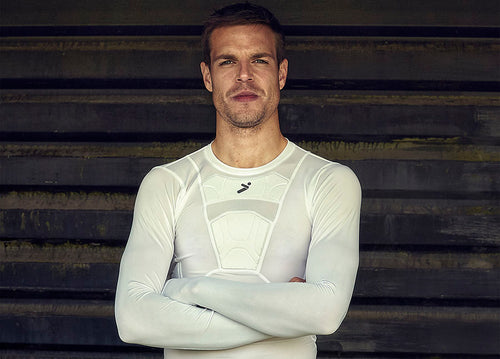
Central Press/GettyImages
Soccer goalie gloves have been around since the late 19th century - they’re that old. A rich history follows the development of goalie gloves, and the manufacturers of these gloves have made many innovations along the way. That includes us here at Storelli. In this post, we’ll take a look at the history of soccer goalie gloves and the innovations we’ve made in the production of our products.
Timeline of Goalie Glove Development
The first mention of soccer goalie gloves likely dates back before your grandparents' birth. The German Patent Office received a patent for a pair of goalie gloves made by British soccer ball maker William Sykes back in 1885. The gloves were to be made with leather and contained a layer of rubber produced in India to reduce the impact of shots.
But the mass production and adoption of goalie gloves would take decades. There was no mention of goalie gloves in the original “rules of the game” published in 1863, so goalkeepers didn’t consider wearing them. In 1934, the Reusch company started to mass-produce soccer goalie gloves.
The 1940s: The Rebirth of Goalie Gloves in Soccer
The Argentine, Amadeo Carrizo, was the first known or at least internationally recognized goalkeeper to wear goalie gloves. A keeper for the River Plate in the 1940s and 1950s, Carrizo was the first goalkeeper to wear goalie gloves regularly. In his case, he wore cotton gloves, which weren’t as grippy and cushioned as leather gloves since cotton absorbs too much water. Nevertheless, he pioneered gloves and likely was a key figure in making the mass adoption of goalie gloves in soccer a reality.
The 1960s: The New Face of Soccer Goalie Gloves
By the late 60s and 70s, soccer goalie gloves were quite popular but still not “law.” Many goalkeepers wore goalie gloves only in wet conditions. Also, there weren’t many options for goalie gloves anyway, so keepers were primarily restricted to wearing gardening gloves. However, the 60s gave rise to the first modern aesthetic of goalie gloves that are standard now.
The 1970s: Goalie Gloves Gone Global
The 1970s was the era when goalie gloves graced the pitch. They emerged from the sidelines, with legendary keepers such as the great Gordon Banks wearing them at Mexico's 1970 FIFA World Cup. Banks’ gloves were still more like gardening gloves (as many early gloves were), but the designs improved as more manufacturers entered the market.
Goalie glove makers such as Stanno, Reusch, Uhlsport, and Sondico began mass-producing gloves to match the newfound and rapidly increasing demand from amateur and pro goalkeepers. The defining characteristic of gloves from the 70s was their simple design but their increased protection and grip from previous decades.
The 1980s/90s: When Goalie Gloves in Soccer Got Cool
The 1980s cemented the goalie gloves as an essential piece of equipment for goalkeepers. It became one of the most prioritized pieces of soccer gear. With that said, manufacturers started experimenting with new designs and features, including terry cloth and latex foam, the latter of which is now a staple. The goalie gloves of the 80s and 90s got more sophisticated thanks to ingenious manufacturers. The features keepers rely on now, such as latex foam casting, emerged from this era.
The 2000s and Beyond: Soccer Goalie Gloves Becomes an Art Form
From the early 2000s onward, there was an explosion of new goalie glove designs and makes. Ergonomics became a significant focus, ensuring that goalkeepers could have a perfect balance of performance, protection (from injury), and comfort. That was the era when unique cuts and seams took the market by storm and colorful design schemes.

(Photo by Francisco Estrada/LatinContent via Getty Images)
For example, additional layers of latex emerged during this era. We all love this feature because it prevents gloves from slipping off a keeper’s hands. Also, roll finger cuts, negative cuts, hybrid cuts, and others became popular after the turn of the century.
Also, those bright and vibrant colors you see in matches and stores are innovations of the 2000s, 2010s, and even the 2020s.
Storelli’s Contributions to Soccer Goalie Gloves
Of course, here at Storelli, we’ve made strides to continuously make soccer goalie gloves that help keepers achieve the best performance possible. We’ve capitalized on much of the earlier inventions of the 20th century and added our innovative touches on gloves. One of our methodologies for designing goalie gloves is to provide keepers with the best of all worlds to perform well without distractions and reduce injury risks. Here’s how we do it.
Storelli’s Goalie Glove Features
- 3mm of cushioning/padding - Often used for palm protection.
- 3.5mm German latex foam - Used to maintain goalie glove grip.
- Roll, Negative, Flat, Hybrid cuts - Moulded to enhance flexibility, fit, and comfort.
- Mesh Fingers/Backhand panels - Enhance comfort by increasing breathability.
- Punch Zones - Provides high amounts of rebound and enhances grip.
- Removable finger spines - Gives goalkeepers the option to protect their fingers against hyperextensions (jammed fingers).
Many of our goalie gloves contain these features so that keepers can perform at a balanced and elite level. We also continuously experiment with new features and constructions so that our goalie gloves can serve goalkeepers of all ages, backgrounds, and experiences to reach excellence in their performance.
The History of Soccer Goalie Gloves Informs their Future
Soccer goalie gloves have improved a ton over the century of their existence. Technology, experience, and experimentation have made goalie gloves more robust and diverse. And, of course, they’re only getting better and will continue to get better. Here at Storelli, we’re committed to being a part of a future where goalie gloves help you unleash new performance levels.
Need a pair of goalie gloves for the goal line? Browse through our selection of goalkeeper gloves to find the right fit and style for you!






















